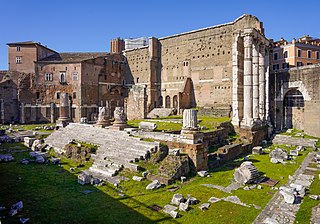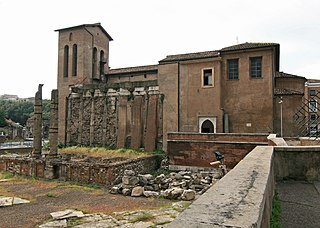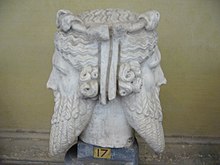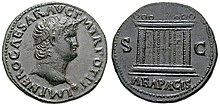This article concerns the period 29 BC – 20 BC.
The Pax Romana is a roughly 200-year-long period of Roman history which is identified as a golden age of increased and sustained Roman imperialism, relative peace and order, prosperous stability, hegemonic power, and regional expansion. This is despite several revolts and wars, and continuing competition with Parthia. It is traditionally dated as commencing with the accession of Augustus, founder of the Roman principate, in 27 BC and concluding in AD 180 with the death of Marcus Aurelius, the last of the "Five Good Emperors".

Nero Claudius Drusus Germanicus, also called Drusus the Elder, was a Roman politician and military commander. He was a patrician Claudian but his mother was from a plebeian family. He was the son of Livia Drusilla and the stepson of her second husband, the Emperor Augustus. He was also brother of the Emperor Tiberius; the father of the Emperor Claudius and general Germanicus; paternal grandfather of the Emperor Caligula, and maternal great-grandfather of the Emperor Nero.

Numa Pompilius was the legendary second king of Rome, succeeding Romulus after a one-year interregnum. He was of Sabine origin, and many of Rome's most important religious and political institutions are attributed to him, such as the Roman calendar, Vestal Virgins, the cult of Mars, the cult of Jupiter, the cult of Romulus, and the office of pontifex maximus.

The Ara Pacis Augustae is an altar in Rome dedicated to the Pax Romana. The monument was commissioned by the Roman Senate on July 4, 13 BC to honour the return of Augustus to Rome after three years in Hispania and Gaul and consecrated on January 30, 9 BC. Originally located on the northern outskirts of Rome, a Roman mile from the boundary of the pomerium on the west side of the Via Flaminia, the Ara Pacis stood in the northeastern corner of the Campus Martius, the former flood plain of the Tiber River and gradually became buried under 4 metres (13 ft) of silt deposits. It was reassembled in its current location, now the Museum of the Ara Pacis, in 1938, turned 90° counterclockwise from its original orientation so that the original western side now faces south.

Res Gestae Divi Augusti is a monumental inscription composed by the first Roman emperor, Augustus, giving a first-person record of his life and accomplishments. The Res Gestae is especially significant because it gives an insight into the image Augustus offered to the Roman people. Various portions of the Res Gestae have been found in modern Turkey. The inscription itself is a monument to the establishment of the Julio-Claudian dynasty that was to follow Augustus.

Pax, more commonly known in English as Peace, was the Roman goddess of peace derived and adopted from the ancient Greek equivalent Eirene. Pax was seen as the daughter of the Roman king god Jupiter and the goddess Justice. Worship of Peace was organized and made popular during the rule of the emperor Augustus who used her imagery to help stabilise the empire after the years of turmoil and civil war of the late republic. Augustus commissioned an altar of peace in her honour on the Campus Martius called Ara Pacis, and the emperor Vespasian built a temple for her on called the Templum Pacis. Pax had a festival held for her on January 30. In art she is commonly depicted holding out olive branches as a peace offering, as well as a caduceus, cornucopia, corn and a sceptre. Pax is also often associated with spring.

The Temple of Augustus and Rome is an augusteum located in the Altındağ district of Ankara. It is thought to have been built around 25–20 AD. Besides being one of the most important Roman-period ruins in the city, it is also known for the Monumentum Ancyranum. This is an inscription about the works of Augustus, who was considered the first Roman emperor. It is the most complete copy of Res Gestae Divi Augusti that has survived to the present day, even as the original in Rome had disappeared.

The Mausoleum of Augustus is a large tomb built by the Roman Emperor Augustus in 28 BC on the Campus Martius in Rome, Italy. The mausoleum is located on the Piazza Augusto Imperatore, near the corner with Via di Ripetta as it runs along the Tiber. The grounds cover an area equivalent to a few city blocks nestled between the church of San Carlo al Corso and the Museum of the Ara Pacis. After being closed for fourteen years to perform restoration work, the mausoleum was reopened to the public in March 2021.
Titus Manlius Torquatus was a politician of the Roman Republic. He had a long and distinguished career, being consul in 235 BC and 224 BC, censor in 231 BC, and dictator in 208 BC. He was an ally of Fabius Maximus "Cunctator".
Sextus Appuleius is the name of four figures during the 1st century BC and 1st century AD. The first Sextus Appuleius was married to Octavia Major, the elder half-sister of Augustus. The three subsequent figures named Sextus Appuleius are respectively the son, grandson and great-grandson of Sextus Appuleius (I) and Octavia Major.
Lucius Arruntius was a Roman admiral. He saw action during the War with Sextus Pompeius, and the war of Mark Antony and Octavian. He is most notable for his participation during the Battle of Actium, where he was in command of victorious Augustus' central division. He was also instrumental in convincing Octavian to pardon Gaius Sosius, one of Mark Antony's generals, after his capture. Arruntius was consul in 22 BC as the colleague of Marcus Claudius Marcellus Aeserninus.

The Forum of Augustus is one of the Imperial fora of Rome, Italy, built by Augustus. It includes the Temple of Mars Ultor. The incomplete forum and its temple were inaugurated in 2 BC, 40 years after they were first vowed.

The Temple of Janus at the Forum Holitorium was a Roman temple dedicated to the god Janus, located between the Capitoline Hill and the Tiber River near the Circus Flaminius in the southern Campus Martius. The temple was built during the First Punic War, after the Temple of Janus in the Roman Forum.

The Solarium Augusti or Horologium Augusti was a monument in the Campus Martius of ancient Rome constructed in 10 BCE under the Roman emperor Augustus. It included an Egyptian obelisk that had first been erected under the pharaoh Psamtik II used in some fashion as a gnomon. Once believed to have been a massive sundial, it is now more commonly understood to have been used with a meridian line used to track the solar year. It served as a monument of Augustus having brought Egypt under Roman rule and was also connected with the Altar of Augustan Peace commemorating the Pax Romana established by his ending the numerous civil wars that ended the Roman Republic. The Solarium was destroyed at some point during the Middle Ages. Its recovered obelisk is now known as the Obelisk of Montecitorio.
Dynamis, nicknamed Philoromaios, was a Roman client queen of the Bosporan Kingdom during the Late Roman Republic and part of the reign of Augustus, the first Roman Emperor. Dynamis is an ancient Greek name which means the “powerful one”. She was a monarch of Iranian and Greek Macedonian ancestry. She was the daughter of King Pharnaces II of Pontus and his Sarmatian wife. She had an older brother called Darius and a younger brother called Arsaces. Her paternal grandparents had been the monarchs of the Kingdom of Pontus, Mithridates VI of Pontus and his first wife Laodice, who was also his sister. Dynamis married three times. Her husbands were Asander, a certain Scribonius and Polemon I of Pontus. According to Rostovtzeff, she also had a fourth husband, Aspurgos.

In Roman Imperial cult, the flamen Divi Julii or flamen Divi Iulii, was the priest of the divinised Julius Caesar, and the fourth of the so-called flamines maiores to be created. The new flaminate was established by the Roman senate in 42 BC, as part of Caesar's consecration as a divus two years after his assassination. Caesar had, in his lifetime, been the recipient of unofficial, divine cult from his supporters, and had designated Mark Antony to serve as his priest. Caesar's cult continued after his death, and in 40 BC, the senate confirmed Antony as the first flamen Divi Iulii.

The Temple of Jupiter Feretrius was, according to legend, the first temple ever built in Rome. Its site is uncertain but is thought to have been on the Capitoline Hill.

Roman Emperor Augustus employed various forms of propaganda as he ascended to power.

Augustan and Julio-Claudian art is the artistic production that took place in the Roman Empire under the reign of Augustus and the Julio-Claudian dynasty, lasting from 44 BC to 69 AD. At that time Roman art developed towards a serene "neoclassicism", which reflected the political aims of Augustus and the Pax Romana, aimed at building a solid and idealized image of the empire.

















